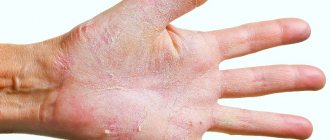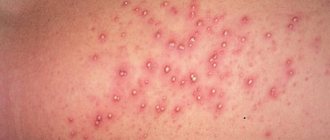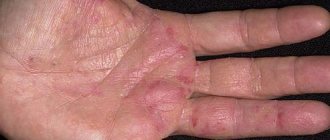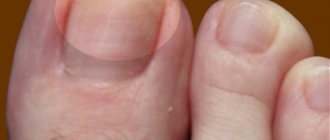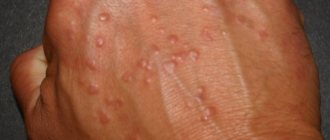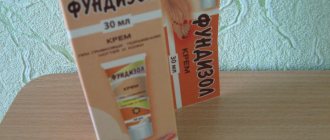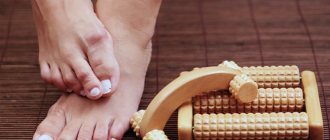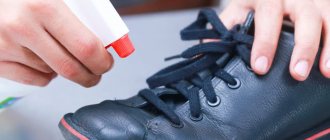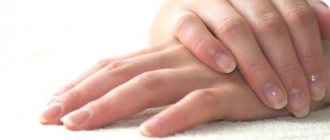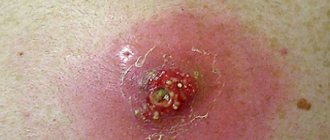The appearance of an ingrown toenail during a natural pedicure is often neglected by girls, especially in the initial stages of progression of the lesion, considering it a cosmetic defect. However, lack of treatment can lead to side effects that will affect the health of your feet.
One of the common complications is the release of pus, which appears when sensitive skin is torn. If the ingrown toenail festers, treatment at home is not suitable; you should definitely consult a doctor to increase the effectiveness of the manipulations.
Symptoms
In addition to purulent discharge, diseases that cause rotting of nails have other symptoms, these are:
- Painful sensations (finger hurts badly).
- Inflammation and redness of the finger.
- Inability to move the affected limb entirely or in the phalanges close to the rotting nail.
- Increased body temperature.
- There are no positive results for a long time and the finger does not heal.
Important! Do not ignore this problem and try not to self-medicate, because this can lead to complications such as sepsis, inflammation of nearby tissues, and limited tendon mobility.
How to understand that a nail is starting to fester
Typically, the development of damage can be noticed visually, but often it has a hidden form, so it becomes noticeable only when it passes into the active form.
In addition, girls, despite having problems with natural nails, often prefer to apply a decorative coating in the form of gel polish, which can visually hide imperfections.
There are several main symptoms of pus:
- Increased swelling of the side cushion;
- Severe inflammation of the affected part and the presence of pain when pressing on them;
- Increase in local and general temperature;
- The damaged area changes - its color becomes darker, spots may appear;
- It becomes difficult to move your fingers and they become less controllable.
When pus appears, it immediately becomes visible, since its large accumulation forms a yellowish spot above the surface of the skin, which can be felt with your fingers.
When the nail bed is severely damaged by pathogenic microorganisms, the girl’s natural manicure gradually begins to thicken and collapse. In the absence of proper treatment, the girl feels severe, sharp pain when walking.
If symptoms of suppuration appear, you should immediately contact a pathologist or surgeon so that he can examine the infected area and prescribe treatment.
Treatment with medications
The classic treatment for rotting nails and nearby tissues is quite simple. If a toe rots near the nail, then in the first stages it is advised to dip the limb in a solution of salt, soda, or furatsilin. Such baths should be done several times a day, changing the main active substance. In the intervals between baths, you need to wear a tight bandage, preferably with medicinal ointments; if the infection is advanced, alternate antiseptic and antibiotic ointments. The same should be done if the problem affects the fingers.
In some cases, antibiotic tablets, general or pathogen-specific, are added to local medications, depending on the complexity of the disease.
The treatment described above is considered traditional, but if we are dealing with an advanced form, then medications are replaced by an operational procedure, which consists of cutting the purulent bags to clean them.
During surgical intervention, the patient’s main question is the preservation of the nail, because if it is necessary to remove the nail, especially on the hand, then in this case you will have to wait a long time for it to fully grow back. Alas, if the nails are rotting on the fingers or toes and the bags are under the nail, then its removal cannot be avoided. Important! You can prevent the problem from developing to the point where surgery is needed if, at the first manifestations of purulent discharge, you begin to treat these areas with any antiseptics available at home.
Onychomycosis
Onychomycosis is a fungal infection of the nail plate. The disease can spread to one nail or several. In severe cases, the epidermis, epithelial membranes and hair are also affected. Most often, the pathology develops due to the proliferation of dermatophyte fungi in the patient’s body, which feed on keratin.
Normotrophic onychomycosis
Attention! In most cases, onychomycosis initially affects the nail plates on the toes, and why does the patient himself transfer the infection to his hands?
Infection most often occurs when the patient visits public places, where the most favorable conditions are created for the reproduction and transmission of the pathogen. The fungus can persist for a long time in warm and humid areas. Cork and wooden surfaces pose a particular epidemic risk, as they have a porous surface. In these microholes, the fungus can exist for several years in a spore state.
Attention! Autoimmune onychomycosis also occurs. With this pathology, pathogens present in the human body, due to a severe weakening of the immune system, begin to actively multiply and infect the nail plates.
Types of onychomycosis
The disease manifests itself with the following symptoms:
- feeling of itching and burning of the skin around the nail;
- deformation of the nail plate, the appearance of depressions, “waves” and creases;
- change in nail color, appearance of gray, whitish or yellowish spots on the nail;
- delamination and fragility of the nail plate;
- peeling of the skin around the nail, the appearance of dry plaques and cracks;
- formation of weeping papules in the interdigital spaces.
Onychomycosis
Therapy for onychomycosis includes the following measures:
- Treatment of the nail and nail bed with products with an antiseptic effect. It is recommended to select drugs with a fungicidal, that is, antifungal, effect. The most commonly used solution is Fukortsin or Castellani . You need to wipe the affected area twice a day.
- To peel off a fungus-affected nail, keratolytic plasters are used: Mycospor , Junlei , etc.
- Application of special varnish coatings to the nail plate to destroy the pathogen: Irunin , Lotseril .
- The use of ointments and gels with fungicidal action. Most drugs also have an analgesic, cooling and antipruritic effect. The most popular are Acyclovir, Mycomax, Terbizil , etc.
Treatment with folk remedies
In addition to traditional medicine, you can also use folk remedies. The main thing is to correctly combine medications and traditional methods, and it is best to consult a doctor.
Method 1 . We are preparing a bath of St. John's wort, plantain and lilac.
To do this, take all the herbs in equal proportions, add a liter of water and put an enamel or stainless steel pan on the fire. After boiling, set the broth aside and let it cool slightly. Strain the broth and place the sore fingers there. The temperature should be somewhere between warm and hot. Keep your fingers in the bath until the water cools down. Before removing your hand from the broth, lightly press on your finger to release the accumulated pus. Important! After the pus has been released, the hand should be taken out and treated with alcohol or other antiseptic and wrapped with a dry, clean bandage.
The broth is poured out and the container is thoroughly disinfected. Method 2 . Similar to the previous one, but instead of herbs we take a weak solution of potassium permanganate. We hold our fingers for 20 minutes and carefully try to squeeze out the pus. After this procedure and antiseptic treatment, you need to apply the grated beetroot to your finger, wrap it and hold it for about 5 hours.
Method 3 . A universal medicine for such purposes is propolis. For the recipe you will need propolis tincture, which is diluted with 5 parts of warm water. You should keep your fingers in this bath 2-3 times a day for up to 20 minutes. No additional actions need to be taken. Just take baths and after a few days, the pus will come out of the formed bags on its own.
Method 4 . In the initial stages, this method can help if the toenail or fingernail is rotting. It consists of putting a couple of tablespoons of salt into hot water and stirring them thoroughly. Dip your finger into the resulting saline solution for a minute or so, then take a short break and repeat again. When the water becomes a comfortable temperature, you can leave your finger until the water cools down. Such an emergency immersion in a highly salty, hot solution stimulates the secretion of pus and is a great help at the onset of the disease.
Onychoschizia - splitting of the nail tissue
This pathology is characterized by destruction of the surface of the plate. In this case, fragility, brittleness, and splitting are observed. The development of onychoschisia is provoked by:
- fungal infections;
- mechanical injuries;
- thermal burns;
- contacts with chemicals;
- deficiency of vitamins, microelements;
- use of low-quality varnishes;
- allergic reactions.
To cope with pathology on the hands, dermatologists recommend:
- taking vitamins A, group B;
- performing hot baths with gelatin and essential oils;
- applying masks with natural wax;
- rubbing olive, sea buckthorn oil;
- the use of bandages with hydrogen peroxide;
- carrying out physiotherapy – phonophoresis.
- Baked pike in the oven
- Health disc for weight loss - reviews of classes. Exercises with a health disc for weight loss, video
- How to put cans on your back
Preventive measures
Excluding systemic diseases, you can protect yourself from most of the causes of rotting fingernails and toenails by following these tips:
- cuticle care procedures .
- Make sure that tools are disinfected before use, and also disinfect tools when doing a manicure or pedicure at home.
- Avoid excessive nail growth or excessive cutting.
- burrs carefully .
- Do not use chemicals to which you are allergic.
Psoriasis
Psoriasis of nails and fingers
Psoriasis is a chronic disease of non-infectious origin, which in most cases affects the epidermis. This pathology is included in the group of lichens, but is of an autoimmune nature and is not transmitted from person to person. Psoriatic nail lesions are quite rare. In most cases, it manifests itself as a syndrome of psoriasis of the epidermis or joints.
Attention! In rare cases, nail psoriasis develops as an independent disease. In this case, it can be quite difficult to differentiate it from onychomycosis.
Nail damage due to psoriasis
Symptomatic manifestations of the pathology directly depend on the form of psoriasis. Most often, patients experience the following manifestations of the disease:
- Itching and burning of the epidermis around the nail, peeling and the appearance of scales and cracks.
- The appearance of an inflamed, hyperemic border around the perimeter of the affected nail bed.
- Changes in the structure and color of the nail. The nail plate quickly deteriorates and becomes grayish or yellow-brown in color. When pressed hard, the nail bends or crumbles.
- Furrows, depressions and loose areas of dull yellow color form on the surface of the nail plate.
- Due to the thinning of the nail, capillaries and petechiae - small subcutaneous hemorrhages - can be visible through it.
Nails with psoriasis
Damage to the nail plate with psoriasis
Treatment of nail psoriasis is usually based on the use of topical agents:
- Creams containing steroids. Hormone-containing drugs are aimed directly at eliminating the pathological autoimmune process. In most cases, specialists prescribe Triamcinolone or Prednisolone .
- Medicines with vitamin D3. They are necessary to strengthen the nail plate and stop the formation of psoriatic plaques. Taklonex, Tacalcinol and Daivonex are used to treat psoriasis .
- Medicines with a dermatotropic effect. They are aimed at reducing the formation of pathological cells and, as a result, reducing the clinical symptoms of the disease or forming remission. For psoriatic nail lesions, Dithranol, Dimexide, Anthralin .
- Salicylic acid solution . You need to wipe the affected area with this product daily to remove keratinized particles and plaque that have formed on the surface of the nail.
Attention! It is recommended to use products containing corticosteroids for no more than 5-7 days in a row. Only a doctor can prescribe the medication regimen and dosage.
Treatment of psoriasis
Physiotherapy is also used as part of complex therapy: magnetic wave procedures, phonopheresis, ultraviolet treatment and local baths .
Attention! Psoriasis is an autoimmune disease. To prevent relapse of the pathology, it is necessary to maintain the normal functioning of the immune system.
Why do toenails grow in?
Knowing the objective reasons why toenails grow in will help you avoid similar problems in the future. So, the reasons are as follows:
- Improper cutting of nails. Oddly enough, the problem of ingrown toenails most often plagues clean people. Some people cut their toenails too deep and short, giving their nails a rounded shape. As a result of improper trimming, nails grow into the skin, most often on the big toes. We will talk further about how to cut your nails safely and competently.
- Tight, narrow shoes compress the phalanges of the fingers, causing constant trauma and friction, which ultimately leads to ingrown toenails. Injury can even lead to purulent inflammation of bone tissue. High heels, tight stockings and socks also provoke inflammation.
- Fungus also contributes to ingrown toenails. With mycosis, the toenails split and become brittle, bend, grow into the nail fold, damaging the tissue.
- A constant traumatic factor, for example, when ballerinas have to dance on their toes for a long time, and hockey players have to run in hard skates. Regular rubbing and squeezing can eventually lead to sore big toes.
- With flat feet, nails often grow into the skin due to the physiologically incorrect position of the foot while walking.
- Patients with diabetes are also at risk.
- The genetic factor is the last reason.
Using ready-made ointment
Is it really effective? An ointment that draws out pus from a closed wound helps well against abscesses. You can buy it at the pharmacy. Today, Vishnevsky’s ointment is most widely used. It contains castor oil, tar and xeroform. The ointment has a yellowish color and has a specific odor. This product helps improve blood circulation and also promotes rapid healing of wounds.
How is balsamic liniment according to Vishnevsky used? What does the ointment help with? A gauze compress with a small amount of the mixture is applied to the affected area and secured with a bandage. The bandage is usually applied for 10-12 hours. It is better to treat abscesses in the evening and leave the compress on overnight. After removing the bandage, the wound must be treated with a disinfectant solution, and then the ointment must be applied again. This procedure can be repeated until the abscess is completely cured.
So, we found out why balsamic liniment according to Vishnevsky helps. The most important thing before applying to a wound is to read the instructions. Is there another ointment that draws out pus from a closed wound, besides Vishnevsky? Levomekol is quite effective. You can also use natural oils, such as castor or sea buckthorn.
Antibiotic-based ointments demonstrate a good effect in the treatment of abscesses. These include Tetracycline, Syntomycin and Erythromycin. They have an anti-inflammatory and antimicrobial effect on the affected area, and also significantly speed up the healing process. Suitable for topical use.
When the purulent capsule breaks through, the affected area should be treated with antiseptic compounds. They will help minimize the consequences of the abscess. Iodine-based preparations are very helpful for treatment. You also need to monitor the condition of the skin around the wound. Experts recommend treating the area around the broken abscess with Dioxidin. For minor suppurations, Miramistin helps well. This is a new antiseptic composition that can be used to clean wounds.
Felon
What it is? If an abscess appears on the finger near the toenail, or, scientifically speaking, a panaritium, it is necessary to immediately begin treatment. Otherwise, the infection may spread to neighboring or the area between them. Such a violation can occur due to many reasons: fungal skin lesions, ingrown toenails, diabetes mellitus, hangnails, poor personal hygiene, bruises.
An abscess can develop in both adults and children. It is enough for a staphylococcal or streptococcal infection to get into a small wound, and serious suppuration forms. An abscess on the big toe can cause serious discomfort and interfere with your normal lifestyle.
The disease occurs in both acute and chronic forms. The progression of the disease can occur very rapidly. Pus accumulates near the nail plate. This is typical for the acute stage. In chronic disease, the inflammatory process develops quite slowly. Yeast bacteria or infections can get into the space near the nail. As a result, the area becomes inflamed, swollen and very red.
Prevention
Most abscesses occur due to damage to the skin. If you follow simple recommendations, it will be much easier to prevent this disease:
- All injuries and wounds should be immediately treated with an antiseptic solution. Brilliant greens, hydrogen peroxide, alcohol or iodine will help here.
- If you don’t have any funds at hand, you can add a leaf of plantain or coltsfoot.
- When leaving to rest, you should take with you Vishnevsky ointment, Levomekol, local antibiotics, a bandage and cotton wool.
- After going outside or doing dirty work, you should wash your hands thoroughly.
- Do not allow dirt to get into wounds or cracks.
- You need to trim your nails carefully.
- Should be removed immediately

